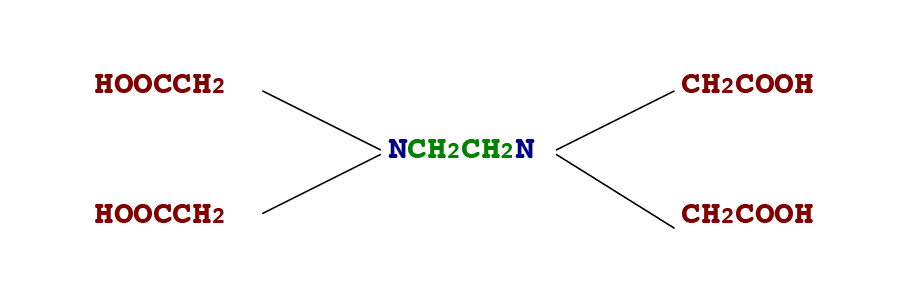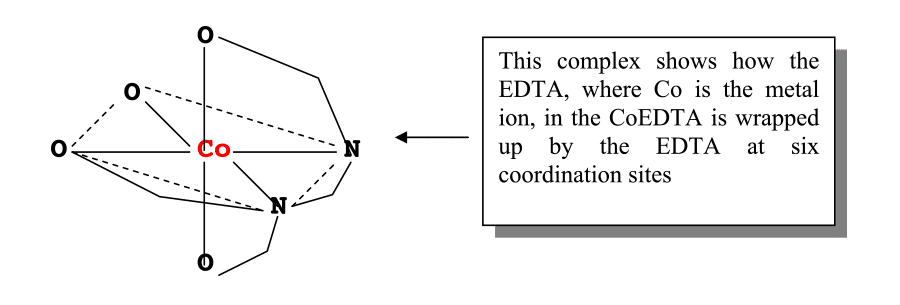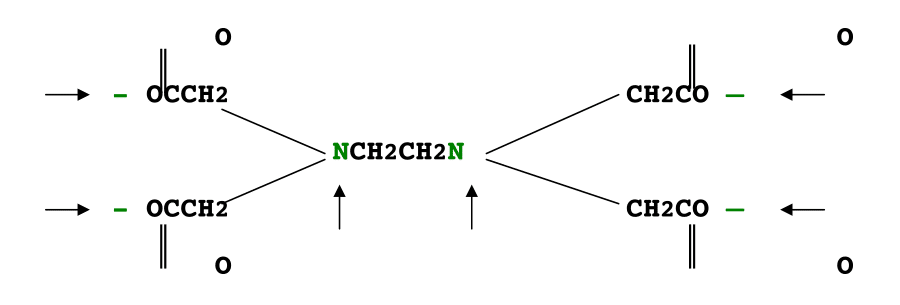PURPOSE: To remove cationic deposit forming salts, as calcium and magnesium, through the formation of a soluble by-product.
Some cationic salts of calcium, magnesium and in many cases iron are present in the boiler feed water. These salts will concentrate in the presence of other boiler water components during the process of steam generation. Since these materials are inversely soluble in water, the normally water-soluble calcium, magnesium and iron lose the ability to remain in solution and precipitate as a hard solid. This inverse solubility allows these salts to form an insulating deposit on the boiler metal surfaces. This deposit will then obstruct heat transfer, which leads to metal failure because of overheating, fuel wastage and inhibition of fluid flow.
A chelant prevents the formation of these deposits by reacting with the cations (positively charged particles of calcium, magnesium and iron) in the feed water, to form a soluble salt. Hence, if a test tube of hot feed water were to have a scoop of calcium carbonate added to it, it would appear to have a heavy adherent white sludge on the bottom of the test tube. If a sufficient amount of chelant is added to the test tube, it will react with the calcium carbonate and the test tube will appear to have nothing but clear feed water in it. The chelant reaction has created a soluble salt with the calcium. Chelants can provide, therefore, improved boiler efficiency when compared to most other internal programs. They remove the deposition potential from the boiler water.
In addition, a chelant will seek calcium and magnesium, which has been already deposited in the boiler. This procedure is called a “CHELANT CLEAN UP” and it essentially is the process whereby old deposits are slowly removed by solubilizing the deposit binders (calcium and magnesium), thus allowing the deposition to be slowly removed from the tubes. Chelant clean up programs are enhanced with the use of dispersants. Dispersants improve the ability of the chelant to remove old deposits by assisting in the suspension of the sludge formed from the chelant clean up of deposits. It is important that the selected dispersant is specific to the type of deposit that is being removed, for optimum performance.
The two chelants usually used in boiler water treatment are: EDTA (ethylenediaminetetraacetic acid) and NTA (nitrilotriacetic acid). These chelants form stable complexes with boiler water cations. The small molecular size of the chelant-cation complex allows this combination to be stable and soluble in the boiler water. This reaction, therefore, creates a soluble salt rather than a solid precipitant.
This soluble salt formation reduces the level of suspended solids in the boiler. Reduction of suspended solids, allows the system to reduce the quantity of blow down from the boiler. All of this relates into;
Chelants provide less fuel wasted in blow down, a cleaner boiler and a more efficient fuel to steam operation.
A chelant should be fed through a stainless steel quill placed in the feed water line. The injection point must be downstream of the feed water pump and at least five feet up stream from any bend in the feed water line. Proper installation will prevent copper loss from the feed water pump impeller as well as any erosion of the feed water piping at elbow bends. This allows maximum contact between the chelant and the feed water impurities to be treated. Feeding a chelant to the feed water line has the following advantages:
- The chelant can react to form a soluble molecule before entering the boiler, thus, drastically reducing the potential for boiler deposit formation.
- EDTA breaks down at 300 psig and NTA at 900 psig. The chelant/cation salt complexes are both stable up to 1300 psig. Thus, the maximum benefit from using a chelant can be obtained from the use of feed water line application.
To realize the greatest benefit both technically and economically from the use of a chelant, the feed water must be of high quality. The allowable maximum limits for contaminants in the feed water for the effective use of a chelant are:
Total Hardness 0-2 ppm
Iron 0-2 ppm
Must Be Oxygen Free (EDTA would prefer to react with oxygen)
Should the contaminant levels in the feed water be higher than the above limits, then a chelant program will most likely not be economical for use in the boiler water treatment program.
Chelants can be used in combination with other internal treatment programs, based upon the system conditions. In a plant with high quality feed water and good control, a chelant/polymer program would be the most effective. Where feed water quality and controls are good, but not of the highest quality, then a phosphate/chelant/polymer program should be used by the boiler plant.
Chelant/polymer programs have the potential for being the most effective scale preventative programs for boilers that receive high quality feed water. The selection of a polymer (dispersant) should be based upon the type of contaminants that are found in the particular feed water or the type of deposit that has been found in the boiler. This allows the polymer to compliment the chelant properly.
Chelant – Phosphate Combinations
A combination of phosphate/chelant/polymer is often used when the chelant is of a sufficient level to react with the majority of the feed water scale forming agents and the phosphate precipitates the remaining calcium salts. The phosphate, also, provides a simple test for product feed control.
This approach is described as “substoichiometric” chelant use. The basic concept is that the total chelant requirement is calculated and 80% of this requirement is added. The approach yields practically every benefit achieved with a chelant program, without the possibility of a potential chelant overfeed. The phosphate in the product allows for a simple method for the testing of product level, while acting as a buffer against chelant corrosion.
Chelants are very different to test for accurately. Many times, a plant will show adequate chelant levels while in reality the chelant demand is much higher than the tests indicate. Even more serious, many of the chelant tests used today will show insufficient levels of chelant when there is actually an overfeed situation occurring in the boiler. In this case, the boiler metal will be attacked while the operator is increasing chelant feed rates to overcome what they think is a scaling condition.
Many programs, therefore, are designed to be base fed. The quantity of make up or feed water and the total ppm of cations in the make up or feed water are determined to establish a feed rate for the chelant. Usually a chart is prepared, which is based on these parameters. To simplify matters, many chelant programs use the phosphate/chelant/dispersant approach for accuracy of product level. This approach provides an additional benefit of anion competition between the chelant and the phosphate. This competition allows the phosphate to act as a buffering agent against chelant attack on the boiler metal, in case of an accidental chelant overfeeds. Chelant use is extremely beneficial, as long as it is used properly and under the proper conditions.
Preference of reaction for EDTA on metal ions is as;
Fe+3>Cu+2>Fe+2>Ca+2>Mg+2
CHELANTS
NTA
NITRILOTRIACETIC ACID

FOUR COORDINATION SITES
DOES NOT FORM AS SOLUBLE A COMPLEX AS EDTA
UNUSED SITES ARE SUSCEPTIBLE TO REACTIONS WITH COMPETING ANIONS
EDTA
ETHYLENEDIAMINETETRAACETIC ACID

SIX COORDINATION SITES
FORMS A SOLUBLE COMPLEX WITH CATIONS
HIGH FEED RATE WILL REMOVE MAGNETITE BY COMBINING WITH THE FeO (FERROUS) PORTION OF THE MAGNETITE
FORGIVING TREATMENT
EDTA CHEMISTRY
EDTA-4, as a chelant, reacts with metals as calcium, magnesium, iron and manganese to form a soluble complex.

The molecules or ions that surround a metal ion in the complex are called ligands (this is from the Latin word ligare, which means, “to bind”)
The atom in the ligand that is bound directly to the metal ion is called the donor atom.
EDTA is a polydentate ligand (“many toothed”) because it appears to grasp the metal ion between two or more donor atoms. Polydentate ligands as EDTA are therefore complexing agents, which surround the metal ion in an effect similar to a crab claw. Chelant comes from the Latin chele, which means to “claw”.

